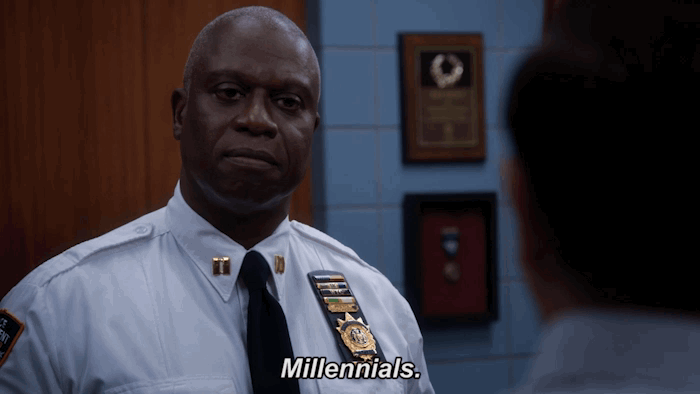Ah, millennials.
The buzzword generation.
The game-changers.
The infamous “killers of industries.”
No matter how you slice it, this generation is different, and so brands must approach them as a new species of consumer in order to truly capture their eyes, ears, and hearts.
As a millennial myself, examining the research regarding my generation was an interesting journey filled with stereotypical confirmations and surprises alike.
Now, let’s see how much of this information is eye-opening to you, too.
This is the third article on millennials I’ve written while on a quest to understand my generation from a marketing perspective, so if you’re not familiar with the demographics of millennials, formally known as Generation Y, check out:
- 41 Revealing Statistics About Millennials to get a solid background of who they are
- How (and Why) to Market to Millennials to get a sense of their overall buying power and marketing preferences
Today, though, we’re doing a deep dive into how millennials spend, save, and shop as the biggest group of consumers in the US, both today and historically.
A quick recap on who these millennials are, in general:
- They were roughly born between 1982 and 1996, so they’re around 22-36 years old.
- There are 83.1 million millennials in the US, making them the largest generation in the country’s history.
- While they are the most digitally-connected generation, they’re a bit more old-fashioned in ways that most marketers don’t anticipate—more on that later on in the purchase methods section.
Without further ado, let's check start with...
Savings

This is an area in which the hand that was dealt to the majority of millennials shows through—from the impact of the Great Recession (with over 15% of millennials losing their job) to stagnating wages and spikes in living expenses, this generation may have good reason for the following facts:
- 72% of millennials have less than $1,000 in savings
- 31% have exactly $0 in savings
- Only 8% have over $10,000 saved
How does this happen?
Well, it turns out that nearly half of millennials are saving at most 5% of their income while only 16% are saving more than 10%.
This could also be attributed to the generation’s overall relatively low financial literacy, but another big suspect is the word that swiftly sends young people into a panic: debt.
Consider that student debt is record high, with the average student loan debt for women clocking in at over $14,500. While men owe $8,500 out of college, almost half of the amount owed by women, it all adds up when lumped with total debt, which for men is around $53,000. While it’s almost 30% lower than what millennial women face, at $69,000, it’s all grim news that may be a key indicator of how millennials allocate their money.
It’s important to note that high unemployment rates and too many low-paying jobs could be affecting the duration with which millennials have to carry the financial burden of their higher education, too.
While these people have less credit card debt and car purchases than other generations, it may be heavily due to the fact that lenders are tightening the requirements for taking out loans and credit extensions.
This alone has helped reduce the amount of consumer debt that millennials face, even if they still have to worry about other varieties.
To avoid credit card debt altogether, mostly out of fear, over 65% of millennials don’t have a credit card at all.

Those who do, though, actually have good credit scores, with the average female having a healthy credit score of 666, compared to 661 for males. A startling majority of millennials, however, don’t know their credit score at all—that’s true for 76% of women and 82% of men.
While they’re not so on top of their credit, millennials do know their financial goals well: female millennials predominantly focus on growing their savings account while male millennials prioritize growing their income.
The single biggest change in savings for millennials, when compared with all previous generations, is their lack of purchasing homes: more young adults live with their parents than ever before.
This is good news for almost any industry besides real estate, as it means that millennials have more budget allocated to other things that would normally go toward a mortgage. Even with fewer millennials taking out mortgages than older generations, older millennials are still settling down and starting families.
Financial Planning

Millennials are decidedly more planning-oriented than their parents or grandparents ever were.
How?
Over a third have a written financial plan—compared with only 21% of Gen X and 18% of Boomers—of which 72% develop their plan with professional help and nearly all go and review or update their plans at least once a year.
In short, they’re financially proactive, are open to getting expert assistance, and are very vigilant of changes as they go along.
Millennials are more likely to monitor their financial accounts and have an understanding of the fees they pay, probably because they know that they face the most uncertain economic future of any generation yet. In fact, this fear leaks into their hopes for their material goals, like finding their dream job, buying a house, and retiring earlier in life.
Investment-wise, millennials highly value social responsibility and environmental-friendliness in what they buy, and so brands have a high standard to live up to if they want this generation’s hard-earned money.
In terms of how millennials decide where to invest, they typically choose to either follow their own instincts or go along with their peers—most importantly, they have become rather wary of financial advice given by parents (who they may perceive as having lived in “easier times”) and professionals in the field.
This shows a little of the rugged, do-it-yourself (DIY) spirit of the generation, where millennials may feel like they have more work cut out for them than ever before.
Finally, and quite interestingly, millennials prefer to have a personal connection with those who manage their money. This reflects their highly-held values of trust, authenticity, and choice.
Spending Habits

Millennials spend $600 billion annually, which comes out to 28% of all daily spending per person. That’s a big chunk of money, which is why so many brands are scrambling for this generation’s attention and patronage.
How and what do they decide to buy? Let’s take a closer look.
When millennials make the purchase decision, the winning factor is...price!
Nearly 80% of millennials are influenced heavily by price when shopping, especially in the form of discounts. In fact, they value price over their friends’ recommendations, the brand’s reputation, and even product quality.
The majority of millennials follow brands online just for discount opportunities, too. While we’ll touch on loyalty in a bit, it can be disheartening to learn that 66% of millennials would switch brands if offered at least a 30% discount.
Worse yet, only a third of millennials follow brands for trends and product updates, and a measly 7% do it to truly participate in the community.
If your angle is to get a conversation going around your brand, your best bet is to center it around offers, at least until you rack up enough loyalty to build a community around.
Discounts are paramount to the shopping experience:
- 72% of millennials search for a discount before purchasing online
- 52% search for a discount before purchasing offline
- Overall, millennials spend an average of 3 minutes searching for discounts before they make a purchase
If a product can’t get any cheaper, other values that brands could focus their efforts on nailing are authenticity, local sourcing, ethical production, a great shopping experience, and giving back to society.
In fact, millennials are so fed up with corporate greed that 75% of them consider it fairly or very important that brands give back to society instead of just making a profit. Bad news for big corporations; great news for small business that are striving to make a positive impact on the world.
Going back to the notion of brand loyalty, while it may seem like any millennial will switch to the cheaper “dark side” at any moment, it’s not exactly that simple.
60% of millennials claim they’re often or always loyal to brands they currently purchase from, especially if treated well via a customer-centric experience. Some of the most impactful elements a brand could provide to ensure allegiance include loyalty programs with custom discounts as well as active courtship.
If your brand can make a millennial feel like a valued customer, you’re in.
Since almost all millennials expect effort from the brand, an easy way to deliver on the expectation is to send them coupons via mail or email.
Other channels, like texting, only have an effect on slightly more than half of millennials, even though this generation practically lives on its smartphones.
Interestingly, uniqueness isn’t the predominant motivator behind the types of products millennials buy, with over 75% of millennials wanting to have the same clothes, cars, and technological gadgets as their friends.
How did we get here?
Well, a lot of the social pressure of materially “fitting in” comes from the dominance of social media in millennials’ lives: oftentimes, friends will post their financial milestones—buying a car, house, and so on—on social media for attention (or praise from their peers).
There’s a gender split here, too, as men feel more inclined to have as many material goods as their friends, but women lean toward frugality and emphasize saving money.
Fashion-wise, millennials want to buy designer clothes, but they do it at discount store prices.

Their generation is frugally fashionable, with secondhand items growing in popularity.
Thrift shops alone—both online and offline—are growing at a rate of 20 times faster than traditional retailers, with the apparel resale industry alone racking up over $18 billion in annual profit.
It makes sense, too, as 30% of millennials claim to shop secondhand at least once a year, and another 21% will continue to shop secondhand into the future, proving it’s not a fleeting trend.
So, what’s the allure of thrifting, besides how Macklemore made it cool in his 2012 hit “Thrift Shop?” Many millennials love it because of three elements: it’s cheap, the items are unique, and it’s an environmentally-friendly way to shop.
If there was a single perfect headline to sum up millennials’ purchase habits, it would read:
“the generation that purchases cheap beer...but fine wine”
This alone shows how millennials don’t spend a lot or a little in general; it all really depends on the product or service itself.
For instance, millennials spend more than any other generation on comforts and conveniences, like taxis, “craft” coffee, and eating at trendy restaurants:
- 60% of millennials spend more than $4 on a single coffee
- 70% of millennials will spend a little extra to eat at the hip restaurants in town
- 69% of millennials buy clothes for reasons beyond basic necessity
- Over 50% of millennials spend money on taxis and Ubers while only 29% of Gen X and 15% of Boomers do the same
It’s important to note, for the final statistic, that car ownership is significantly lower among millennials, even though 71% would rather buy than rent a car. However, it’s one thing to want to buy a car, and a whole other to be able to do so.
It’s safe to say that convenience and short-term affordability factor into the high spending amount on taxis and the like.
Millennials have a very active lifestyle, part of which involves going out more than older generations due to the notions of both YOLO (you only live once) and FOMO (fear of missing out). These people eat out 5 times a week, which naturally accrues gas and restaurant expenses as a result.
So, how do the generations look side-by-side with spending?
Millennials tend to spend more per year on:
- Groceries
- Gas
- Restaurants
- Their cellphone (nearly 98% of millennials own a smartphone and have the highest usage, too)
- Hobbies, electronics, and clothing
At the same time, millennials spend less than older generations on:
- Television (millennials don’t pay for cable; they buy or share streaming services instead)
- Travel (although saving up for a trip is a big financial goal for many millennials, it’s not happening yet…)
- Pharmacies
- Furniture/building materials
If your brand falls into any of the categories above, this is crucial data you should look into when you’re building out your buyer personas.
Although more than half of millennials don’t have credit cards, the other half rely on them for basic daily necessities, such as food and utilities.
Cash is becoming increasingly more rare these days, which could be bad for millennials:
- Over a quarter of millennials have late payments or are dealing with bill collectors
- Over half are still receiving some type of financial aid from their parents
This in turn makes the generation, as a whole, financially unstable, as 70% of them define financial stability as being able to pay off all their bills at the end of every month.
So, do millennials justify making purchases outside of essentials?
Yes, when they fall into their favorite product or service categories above—an important point to remember when assessing the ROI on marketing to this generation.
Purchase Methods

While it’s all-too-common to hear people go on and on about how we’re living in “a digital era,” this may come as a surprise: the majority of millennials make most of their purchases offline, not online.
What?! How?! Why?!
Shocking, I know. Let’s break it down in backward order...
The why:
It turns out that millennials enjoy experiencing the product before purchasing—that is, they want to touch, hold, and smell the product first.
They love shopping at particular types of stores for the overall experience, too. The top brick-and-mortar store choices for millennials are drugstores, department stores, discount or mass merchant stores, and consumer electronics stores. This trend is especially true in younger millennials, surprisingly.
The how:
Even though 54% of millennials shop online, this generation is more likely to do the research and then head to a “real” store to make the actual purchase.
While brands with physical locations may be tempted to sit back and let out a long-overdue sigh of relief, there’s more to it than doing what you’ve always been doing: now, millennials prefer—nay, expect—a seamless experience on all channels when shopping.
If you’re baffled by what this could possibly be, here are common examples: digital coupons that work in-store, personalization of messaging and offers, connected shopping, integrated merchandising, fulfillment options that are flexible, and overall better services to improve the shopping experience.
The what:
A third of millennials make most of their purchases on their desktop computers, and even fewer shop on mobile—16%, to be exact, with this being more true for older millennials (21% of whom make an online purchase every week) than younger ones.
More likely than not, millennials are using their smartphones to compare prices to other retailers while they’re browsing in-store and will put the product back on the shelf if they find a better deal elsewhere. (Yes, price is that important of a factor!)
More millennial women shop in stores than men, too. This is largely due to differing product purchases and industry interests, as buying makeup online without testing it is not as “safe” or appealing an option as going into the store first.
Millennial moms, too, are tech-savvy shoppers, relying on mobile phones in the purchase process quite a bit:
- 79.4% use their phone to search for the best price on a product
- 68.9% use their phone to read product reviews
- 67.1% use their phone to download coupons
In short, if your brand’s online-to-offline experience is easy to navigate, millennials will be sure to prefer it over your less-tech-savvy competitors.
One final note that is crucial to bring up is how millennials perceive renting versus owning.
While some big, older brands may panic at the following data, it also makes room for new, niche industries to arise and flourish:
- Millennials are 4.6 times more likely to rent products online
- They’re also 2.3 times more likely to use sharing services
Home ownership is an industry that’s majorly affected by this generational shift, too.
It turns out that 56% of millennial men and 44% of millennial women own a home, but women in this generation are twice as likely to be living with friends or family rent-free (remember how they strive to grow their savings?).
Overall, 59% of millennials would rather rent a house than buy one, and one of the key reasons may be that at least 61% of them can’t afford a house anyway.
Landlords everywhere are sure to rejoice from this news—as long as economic conditions stay the same, millennials aren’t going to predominantly become homeowners anytime soon.
Advertising

Get ready for this number, because it’s going to sting a little...a recent survey found that only 1% of millennials said that a compelling ad would make them trust a brand more.
Harsh, I know, but it’s just further proof that traditional advertising needs to adapt for a modern audience.
Traditional advertising needs to be adapted for a modern audience.
Simply put, millennials outright discount the authenticity of advertising, which just makes a stronger case for inbound marketing as an effective strategy.
Concrete proof of this repulsion to advertising is the popularity of adblocker software: 64% of millennials use some form of it on desktop, mobile, or both, and only 36% don’t.
While older generations rely more on traditional media to make educated purchases, millennials look to social media instead, especially assigning value to the opinions of their trusted peers.
So, what are marketers to do?
Luckily, there are a few highly effective forms of marketing that resonate with millennials when done well.
1: Experiential Marketing
One of those is experiential marketing, naturally, as millennials are the generation that prefers experiences over material things.
It’s so effective, in fact, that a whopping 98% of participants in a particular survey were more inspired to purchase the featured product after participating in an experiential campaign around it.
This approach isn’t difficult or costly, either, as it could be as simple as hosting a live presentation or having a representative present to answer customer questions about the product.
2: Influencer Marketing
Influencer marketing works, though it’s important to note that, the more famous the influencer is, the less effective the campaign will be.
Millennials are much more likely to listen and connect with “normal” people that are similar to them, not celebrities.
This creates a wonderful opportunity for your brand to leverage microinfluencers, or slightly famous people with a substantial—but not massive—following in a particular niche.
YouTube is a great channel to turn to for finding these kinds of pseudo-celebrities: 60% of millennials would try a product suggested by a YouTube creator over a celebrity.
Furthermore, 70% of millennials are influenced by non-celebrity bloggers, too.
3: Cause Marketing
Millennials are also highly receptive to cause marketing, too, and significantly more so than older generations.
Millennials prefer to actively engage in a cause-based campaign in two ways: by encouraging others to support the cause or by participating in fundraising events.
Ironically, only 4% are more likely to volunteer their time, leading to some major slacktivism as a generation, but they show support in other meaningful ways nonetheless.
Most importantly for brands, millennials are 37% more likely to buy items that are associated with a particular cause, so if your brand is pushing product that’s setting out to save the world, you’re on the right track.
4: Content Marketing
Finally, but not least importantly, content marketing is an excellent way to tap into the millennial market and get them to notice your brand.
Consider that millennials are just as eager to share friends’ content as they are to share branded content (so long as they found it entertaining).
What makes millennials hit the share button?
- They identify with the content
- It provides value to them
- It reaches them in an authentic and transparent way
- 60% of the time, it’s because it’s thought-provoking and intelligent
- 70% of the time, it’s just plain funny
You may be thinking, that’s all fine and dandy, but if everyone’s doing it...how do I make my brand stand out?
I have one word for you: personalization.
If millennials feel that their needs are being accounted for within niche groups, they’re happy to share. This is best done with social media, where brands can offer exclusive discounts to their page fans or to individuals via messenger.
Positioning social media in the forefront of your content marketing strategy can be very beneficial, but it has to be done the right way.
Your brand needs to create a positive buzz and be part of millennials’ conversation in a natural way to be most effective. This means that your content needs to delight them into wanting to share your content and support your brand without explicit incentive.
Your content needs to delight your audience into wanting to share your content and support your brand without explicit incentive.
Otherwise, your best bet for gaining loyalty comes in the form of offers and personalized discounts—and if you don’t want to be competing by price, then you better put great effort into creating buzz.
Knowing where these young adults are is key, too—81% of millennials are on Facebook, so that’s a good place to start. (If you’re new to using this social media platform as a marketing channel, we have a guide that’ll get your Facebook strategy up and running in no time.)
Also, your brand needs to offer an enticing yet non-intrusive experience. Millennials check their smartphones an average of 43 times a day, giving you a variety of time windows to work with for nailing that first impression. It’s tempting to want to get their attention online with outbound methods, but it’s sure to annoy millennials more than anything.
Luckily, a solid 40% of millennials use social media to record their experience after using a product, so a great strategy would be to take this user-generated content and use it as an authentic and natural means of showing off your products without being pushy or boastful.
The Bottom Line

If your image of these young and feisty millennials was blurry upon embarking on this journey, I truly hope that you can now see this audience segment through a crystal clear lens.
In a nutshell, millennials are...
The buzzword generation that has most brands panicking and throwing all of their old tactics out the window.
The game-changers who demand that companies do the right thing in order to make a healthy profit.
The infamous “killers of industries” with their radical ways of purchasing—or not purchasing—historically popular products and services.
There are some key takeaways that are important to understand in order to successfully convert millennials into loyal, long-lasting customers for your brand:
1: don't over-generalize
First off, while it’s important to look at data and trends to gain an understanding of millennials as a whole, one of the most crucial insights is that we’re talking about the most diverse generation of all time.
Generalizing too much, therefore, is a dangerous move because you can end up isolating all millennials instead of authentically relating to some specific characteristic-based segments of the group.
2: inbound marketing is key
This generation is quite jaded; they know what brands are trying to do with ads, and they don’t like it.
Millennials tend to see the customer-brand relationship more as a courtship than a show-and-tell extravaganza.
Non-traditional means of advertising are the best way to tap into millennials’ loyalty and patronage, so if your brand hasn’t moved past relying on billboards, commercials, and other outbound marketing methods to bring in potential customers, it’s time for a major update to your strategy.
3: make your marketing cross-channel
Finally, as an important part of your marketing strategy, you must consider all the touchpoints that millennials prefer, including cross-channel and cross-device marketing and customer service.
Millennials are predominantly multitaskers who tend to fluidly move across platforms and devices during their buyers’ journey, so if your brand wants to be in the running, you need to make the customer’s path from online to offline as seamless as possible.
Whether you love millennials or echo the reaction below...

...Millennials are the most powerful and abundant consumers of our time.
By now, you should have a good understanding of millennials as consumers, and if you’ve read my other two millennial-focused articles, who they are by the numbers and what they prefer in terms of marketing messaging.
What did you find most interesting?
What other information about millennials do you think is a must-know for marketers?
Share your thoughts in the comments below!




